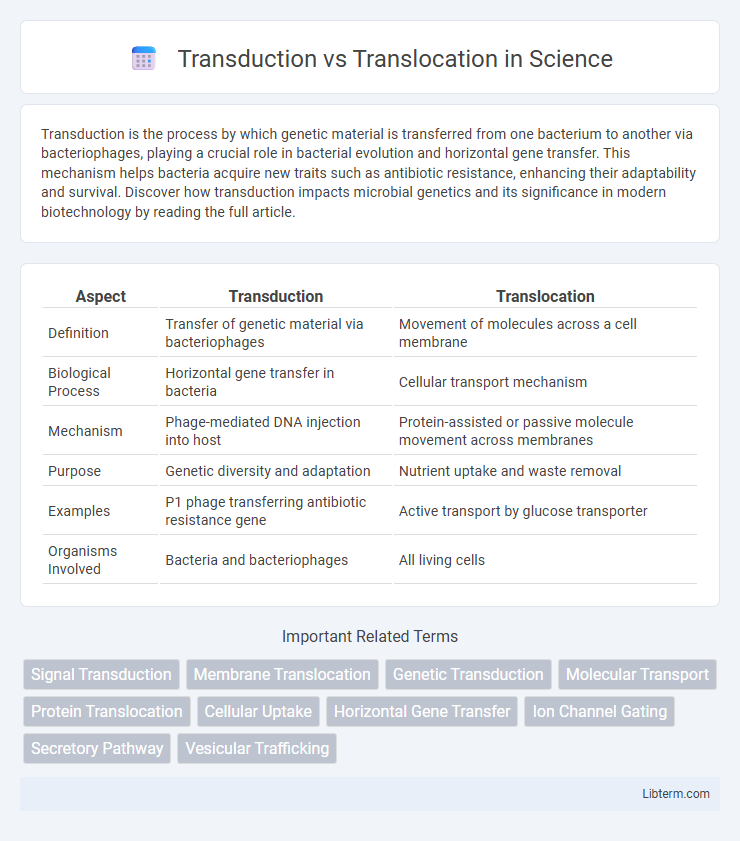Transduction is the process by which genetic material is transferred from one bacterium to another via bacteriophages, playing a crucial role in bacterial evolution and horizontal gene transfer. This mechanism helps bacteria acquire new traits such as antibiotic resistance, enhancing their adaptability and survival. Discover how transduction impacts microbial genetics and its significance in modern biotechnology by reading the full article.
Table of Comparison
| Aspect | Transduction | Translocation |
|---|---|---|
| Definition | Transfer of genetic material via bacteriophages | Movement of molecules across a cell membrane |
| Biological Process | Horizontal gene transfer in bacteria | Cellular transport mechanism |
| Mechanism | Phage-mediated DNA injection into host | Protein-assisted or passive molecule movement across membranes |
| Purpose | Genetic diversity and adaptation | Nutrient uptake and waste removal |
| Examples | P1 phage transferring antibiotic resistance gene | Active transport by glucose transporter |
| Organisms Involved | Bacteria and bacteriophages | All living cells |
Introduction to Transduction and Translocation
Transduction is a genetic transfer mechanism in bacteria where bacteriophages carry DNA from one cell to another, facilitating horizontal gene transfer. Translocation refers to the movement of molecules, such as proteins or ions, across cellular membranes through specific transport systems. Both processes are crucial for cellular function and genetic diversity but operate via distinct biological pathways and purposes.
Key Definitions: Transduction vs Translocation
Transduction is the process by which foreign DNA is introduced into a bacterial cell by a virus or viral vector, facilitating gene transfer between organisms. Translocation refers to the movement of molecules or ions across a cell membrane or the rearrangement of chromosomal segments within a genome, impacting cellular function or genetic expression. Both processes are fundamental in molecular biology but differ significantly in mechanisms and biological roles.
Mechanisms of Transduction
Transduction involves the transfer of genetic material between bacteria via bacteriophages, where a virus accidentally incorporates host DNA and injects it into a new cell, enabling horizontal gene transfer. This process can be generalized, involving random bacterial DNA packaging, or specialized, where specific bacterial genes near prophage integration sites are transferred. Translocation, in contrast, refers to the direct movement of molecules or ions across cellular membranes, typically mediated by transporter proteins or vesicular trafficking, and does not involve gene transfer mechanisms like phage-mediated transduction.
Mechanisms of Translocation
Translocation involves the directed movement of molecules, ions, or proteins across membranes or within cells, primarily driven by molecular motors such as kinesin, dynein, and myosin, using ATP hydrolysis to convert chemical energy into mechanical work. This process ensures accurate intracellular cargo transport along cytoskeletal tracks like microtubules and actin filaments, crucial for cellular organization and function. In contrast, transduction refers broadly to signal conversion mechanisms, often involving receptor-mediated pathways rather than active transport mechanisms characteristic of translocation.
Biological Roles of Transduction
Transduction in biology primarily refers to the process by which bacteriophages transfer genetic material between bacteria, facilitating horizontal gene transfer and contributing to genetic diversity and antibiotic resistance. This mechanism contrasts with translocation, which involves the movement of molecules or organelles within a cell, such as the active transport of proteins across membranes. Understanding transduction is crucial for studying microbial evolution, gene regulation, and the spread of virulence factors in bacterial populations.
Biological Importance of Translocation
Translocation is a critical process in plant biology involving the movement of organic nutrients, primarily sucrose, through the phloem from sources (like leaves) to sinks (such as roots, fruits, and growing tissues), enabling growth and development. This movement supports energy distribution, storage, and cellular metabolism, which are essential for plant survival, reproduction, and response to environmental stimuli. Unlike transduction, which refers to gene transfer by bacteriophages in microbiology or signal conversion in neuroscience, translocation ensures the systemic integration of nutritional resources in plants.
Key Differences between Transduction and Translocation
Transduction involves the transfer of genetic material between bacteria via bacteriophages, whereas translocation refers to the movement of molecules or ions across cellular membranes or the relocation of a chromosome segment within a genome. Transduction is a genetic process crucial in horizontal gene transfer and bacterial evolution, while translocation plays a vital role in cellular metabolism and gene expression regulation. The primary difference lies in transduction's role in gene transfer mediated by viruses, contrasted with translocation's function in molecular transport or chromosomal rearrangement.
Examples of Transduction in Nature
Transduction in nature primarily occurs through bacteriophages transferring genetic material between bacteria, exemplified by the generalized transduction process in *Escherichia coli* where phages mistakenly package host DNA. Specialized transduction is observed in *Salmonella* species when prophages excise incorrectly, carrying adjacent bacterial genes into new host cells. These natural mechanisms facilitate horizontal gene transfer, promoting bacterial evolution and antibiotic resistance spread.
Examples of Translocation in Living Organisms
Translocation in living organisms refers to the movement of molecules or cells from one part to another, exemplified by the transport of sugars through the phloem in plants, enabling nutrient distribution essential for growth. In humans, translocation also occurs at the chromosomal level, where segments of DNA break and reattach to different chromosomes, which can lead to genetic disorders or cancers like chronic myelogenous leukemia. These biological translocations differ fundamentally from transduction, which involves the transfer of genetic material via viruses.
Conclusion: Comparing Transduction and Translocation
Transduction involves the transfer of genetic material between bacteria via bacteriophages, facilitating horizontal gene transfer with high specificity, while translocation refers to the movement of molecules or cellular components across membranes or within cells, crucial for intracellular transport and cellular function. Both processes are essential for cellular adaptation and survival but operate at different biological levels, with transduction primarily impacting genetic variability and translocation maintaining cellular homeostasis. Understanding these mechanisms highlights their distinct roles in molecular biology and their implications for genetic engineering and cell physiology.
Transduction Infographic

 libterm.com
libterm.com